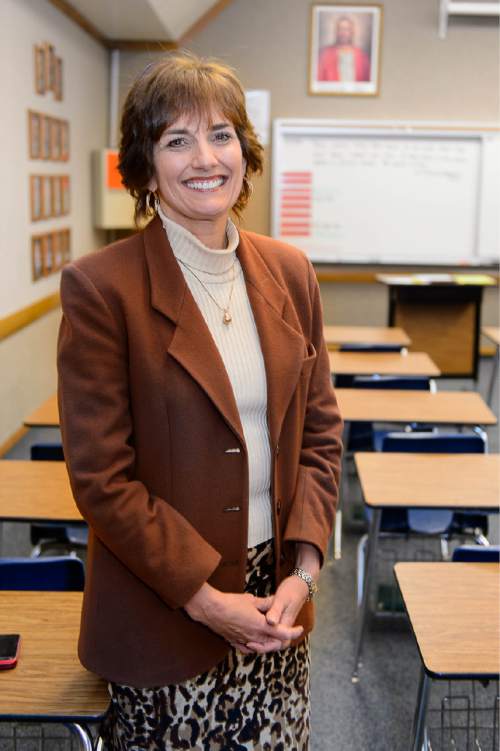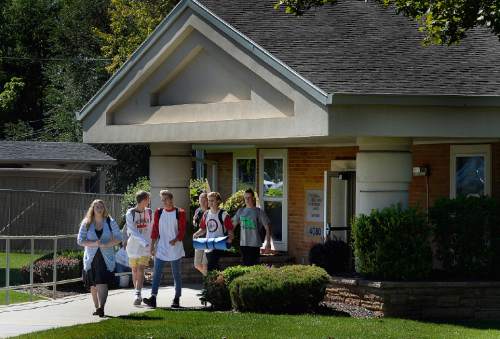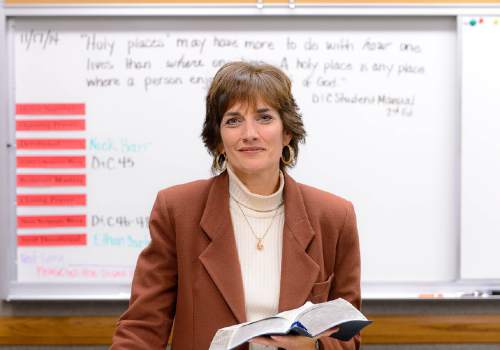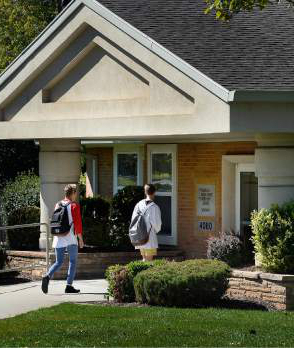This is an archived article that was published on sltrib.com in 2014, and information in the article may be outdated. It is provided only for personal research purposes and may not be reprinted.
Before today, if you were a Mormon woman hired to teach at an LDS seminary or institute, the moment your first child showed up, you lost your job.
If you were divorced but happily married a second time — even for decades — you could not be considered for either position.
Both those policies have been reversed.
Mormon mothers with children in the home as well as members who have been previously divorced now can be hired to teach in one of the LDS Church's seminaries or institutes of religion.
"This change makes it possible for families to decide what best meets their needs as it relates to mothers working while raising children," the Utah-based faith announced Friday in a memo regarding hiring policies. "This policy is consistent with other church departments."
Nearly 800,000 students are enrolled in LDS seminary (junior high and high school) or institute (college) courses across the globe.
This change affects only those 2,200 employees who teach full or part time for The Church of Jesus Christ of Latter-day Saints, most of whom are in Utah and Idaho, with released-time classes.
The vast majority of the church's seminary teachers — some 44,000 — are volunteers, drawn from local congregations, many of whom are women with young children.
LDS officials have discussed the move for some time, says Chad Webb, administrator of the faith's seminaries and institutes.
Believing that the family is a vital part of Mormon theology, he says, officials wrestled with how best to present that in the classroom.
They sought input from top church officials, from women's auxiliary leaders and from teachers in the system, Webb says. "They unitedly felt this was the right thing to do at this time ... to trust our teachers to make the right decisions for their personal and family circumstances."
For Heidi Weed, teaching seminary has been a fulfilling profession, but she came to it after her four children had left for college.
Weed, who has taught seminary for four years at Murray's Cottonwood High, worked as one of those volunteer teachers in Idaho and Kansas while her children were young. Then, when a friend suggested she take it up as a career, she jumped at the chance. She's glad more women will have that opportunity.
"Half of our students are female," Weed says. "Now they will be able to receive an invitation to come unto Christ from someone who represents their point of view."
Female teachers also may help better prepare young women to serve Mormon missions, she says. "They will see modeled in seminary what they will emulate in their missionary labors and in future families — teaching the gospel."
Lori Newbold, principal at Alta High's seminary in Sandy, is single and always thought she would quit when she married and became a mother.
"I was OK with that because my personal desire was to be a stay-at-home mom," Newbold says. "But, until then, this is my perfect dream job."
She also earned a master's degree in mental-health counseling, she says, in case she ever had to go back to work as a married woman or mother.
Newbold sees this change opening the doors "to even more powerful and inspired teachers who could strengthen the youth."
For many people, "life doesn't turn out the way they thought it would," she says. "I love that we can change and grow."
This shift comes amid wide-ranging efforts to enhance the visibility and roles of women in the LDS Church. Leaders lowered the age of female missionaries from 21 to 19, which fueled a dramatic increase in the number of "sisters" serving. Women offered prayers for the first time during the faith's semiannual General Conferences. There even has been an unsuccessful grass-roots drive to ordain women to the all-male priesthood.
The seminary revision "is not connected to other conversations about women," Webb says. "It's just an educational decision."
Even so, Mormon feminists are cheering it.
"This change is the latest in a series of policy changes that indicate our leadership's willingness to consider and embrace best practices for the inclusion of women and incorporate them into our own institution," says Neylan McBaine, author of "Women at Church: Magnifying LDS Women's Local Impact." "As with women's presence in any influential or deliberating body, the increase in women's voices in [the Church Educational System] will result in a richer experience for all our youth, additional role models for our young women and a reinforced message that our women can be leaders in doctrinal scholarship."
Brigham Young University-Idaho history professor Andrea Radke-Moss praised the move for making the policy consistent across church institutions.
The LDS Church "already long allowed for hiring mothers with children as full-time faculty at church universities," Radke-Moss writes in an email. "Further, the fact that the motherhood-status exclusion for women was not similarly applied to female secretaries exposes some gender binaries at play for what was considered 'acceptable' work for mothers. (Secretary, yes, teacher, no.)"
Friday's announcement, she says, "gives great hope that the church can and should be leading the way in encouraging educational and professional choices for women that will empower couples."
It also signals an end to "the old dichotomy between either motherhood or a profession," Radke-Moss says, allowing women to seek "more options for spiritual growth, financial need and professional ambition as part of their life's plan."
Mormon writer and blogger Jana Riess was glad to see the church "acknowledge that individual family circumstances often require women to work outside the home, and that those families can decide about those matters for themselves."
And while Riess "would have preferred the new policy to allow divorced individuals to continue teaching without interruption," she says, "the new policy acknowledges that while divorce is not ideal, lots of people fall short of the perfect Mormon marriage, and they shouldn't be forever prevented from teaching."
The policy for seminary and institute teachers who are divorcing remains the same. Their individual circumstances are reviewed before determining their employment status.
In the 1970s, Philip Barlow, Utah State University director of religious studies, was an LDS institute director in Boston and working on a doctorate at Harvard when his marriage fell apart and he lost his livelihood.
Others spoke to Mormon higher-ups on his behalf, Barlow says, but to no avail.
"Their message was: 'Your cause is just but I can do nothing for you,' " he recalls. "That was a very hard time."
Barlow, who has been remarried for many years, says the change is "long overdue and deeply welcome."
It might not have saved his job, but it does away with the "implied assumption that a divorced person is morally at fault ," he says, a view that "is ill-founded."
This move feels "more authentic and more compassionate," Barlow says, "both for the teachers and for the young students who have encountered hard things and remain true to the faith."
Twitter: @religiongal









